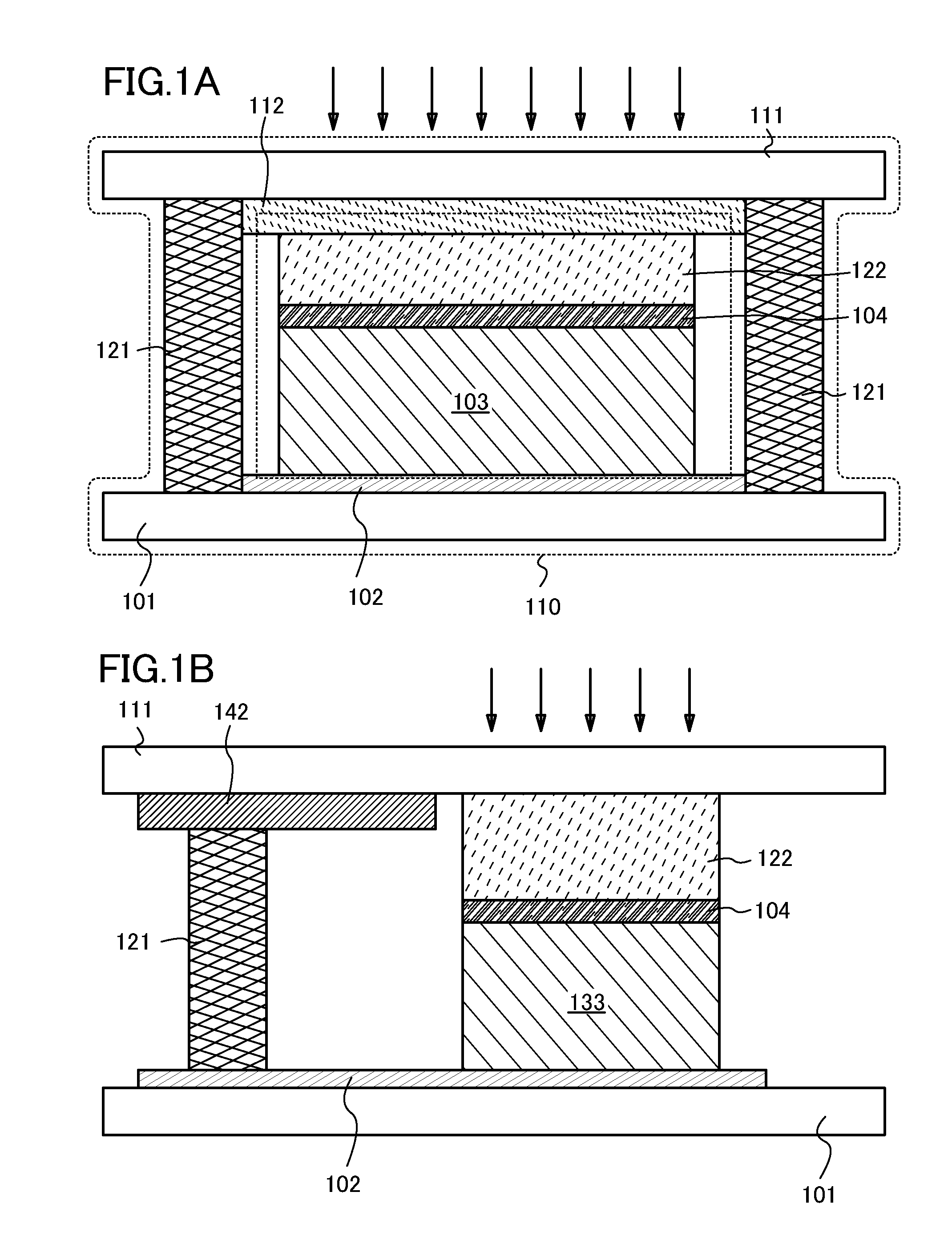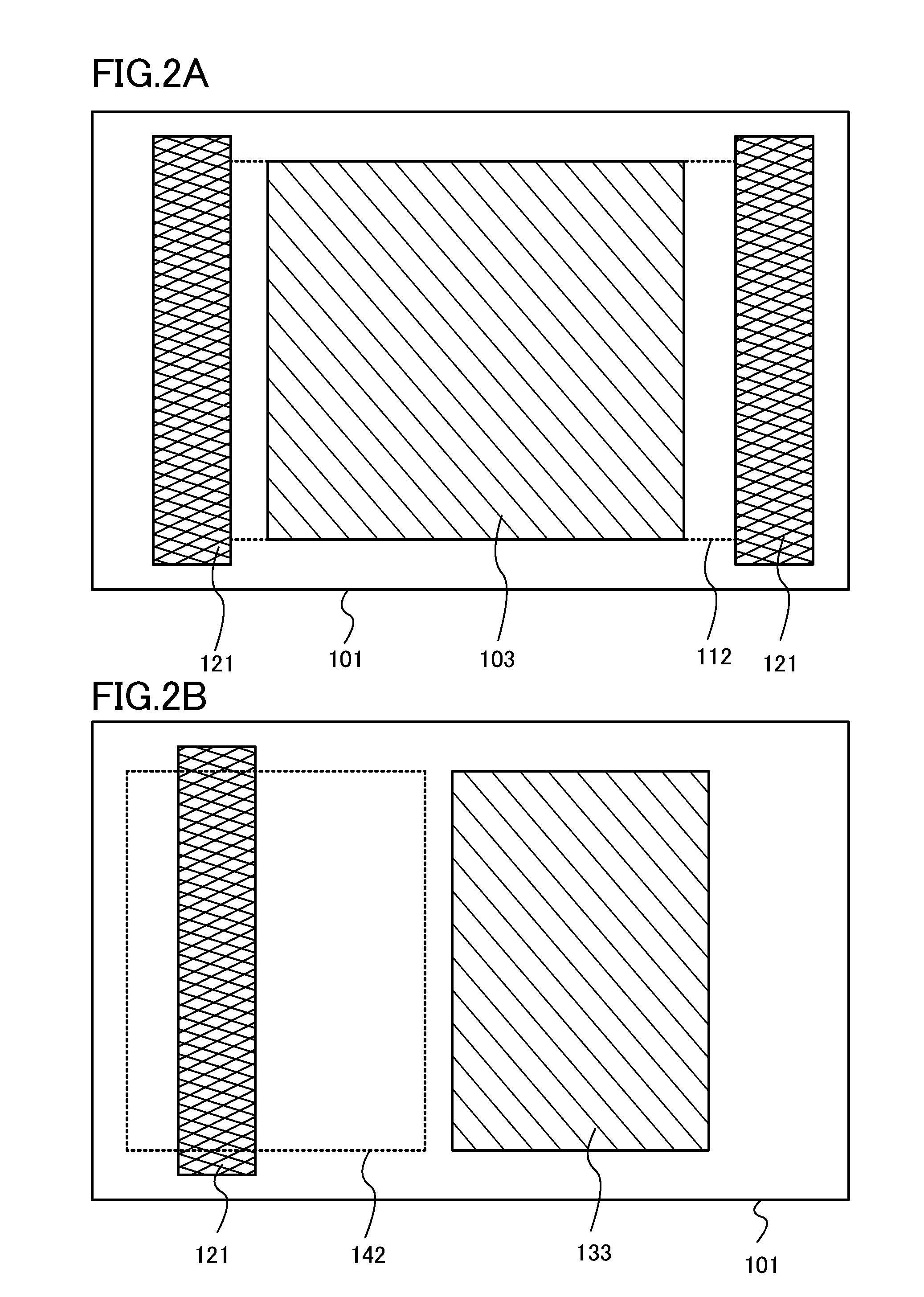Photoelectric conversion device and manufacturing method thereof
a technology of photoelectric conversion device and manufacturing method, which is applied in the direction of sustainable manufacturing/processing, final product manufacturing, vacuum evaporation coating, etc., can solve the problems of high manufacturing cost, difficult to make a photoelectric conversion device including the converter circuit thinner, and the photoelectric conversion device including the converter circuit cannot be manufactured. cost, the effect of reducing the cost of manufacturing the converter circuit and the conversion devi
- Summary
- Abstract
- Description
- Claims
- Application Information
AI Technical Summary
Benefits of technology
Problems solved by technology
Method used
Image
Examples
embodiment 1
[0048]In this embodiment, photoelectric conversion devices each including a photoelectric conversion element and a converter circuit will be described with reference to FIGS. 1A and 1B, FIGS. 2A and 2B, FIGS. 3A to 3C, FIGS. 4A and 4B, FIGS. 5A and 5B, FIGS. 6A to 6E, and FIGS. 7A to 7C.
[0049]FIG. 1A and FIG. 2A illustrate the photoelectric conversion device of this embodiment. For comparison, FIG. 1B and FIG. 2B illustrate a conventional photoelectric conversion device.
[0050]FIG. 1A illustrates a cross-sectional view of the photoelectric conversion device described in this embodiment.
[0051]The photoelectric conversion device illustrated in FIG. 1A includes, over a transmissive substrate 101, a transmissive conductive film 102, a photoelectric conversion element 103 provided in contact with the transmissive conductive film, a transmissive conductive film 104 provided in contact with the photoelectric conversion element 103. Further, the photoelectric conversion device illustrated in...
embodiment 2
[0247]In this embodiment, an example of a circuit structure of the converter circuit described in Embodiment 1 will be described with reference to FIG. 8.
[0248]FIG. 8 illustrates a structure example of a power source circuit 601. The power source circuit 601 includes a voltage conversion circuit 602 which is a converter circuit, and a control circuit 603 of the voltage conversion circuit 602. The voltage conversion circuit 602 is the DC-DC converter in Embodiment 1.
[0249]The voltage conversion circuit 602 includes a transistor 611, a coil 612, a diode 613, and a capacitor 614. The control circuit 603 includes a triangle wave generator circuit 621, a digital control circuit 650, a pulse width modulation output driver 623, a resistor 624, and a resistor 625. In addition, a dotted arrow 627 indicates a loop of a feedback circuit. A feedback voltage Vfb, which is an output voltage of the resistor 624, is input to the digital control circuit 650.
[0250]The transistor 410, the transistor 4...
embodiment 3
[0267]A solar photovoltaic module can be obtained by using the photoelectric conversion device obtained by any of Embodiment 1, 2, or the like. Described is an example in which the obtained solar photovoltaic module is mounted on a vehicle.
[0268]FIG. 9C illustrates an example of the solar photovoltaic module of this embodiment. The solar photovoltaic module of this embodiment is manufactured with the use of the photoelectric conversion device illustrated in Embodiment 1 or Embodiment 2.
[0269]A solar photovoltaic module 5028 in FIG. 9C includes, over the transmissive substrate 101, the transmissive conductive film 102; the photoelectric conversion element 103 provided in contact with the transmissive conductive film 102; and the transmissive conductive film 104 provided in contact with the photoelectric conversion element 103. Further, the solar photovoltaic module 5028 in FIG. 9C includes the converter circuit 112 formed using transmissive materials adjacent to the transmissive subs...
PUM
| Property | Measurement | Unit |
|---|---|---|
| thickness | aaaaa | aaaaa |
| sheet resistance | aaaaa | aaaaa |
| thickness | aaaaa | aaaaa |
Abstract
Description
Claims
Application Information
 Login to View More
Login to View More - R&D
- Intellectual Property
- Life Sciences
- Materials
- Tech Scout
- Unparalleled Data Quality
- Higher Quality Content
- 60% Fewer Hallucinations
Browse by: Latest US Patents, China's latest patents, Technical Efficacy Thesaurus, Application Domain, Technology Topic, Popular Technical Reports.
© 2025 PatSnap. All rights reserved.Legal|Privacy policy|Modern Slavery Act Transparency Statement|Sitemap|About US| Contact US: help@patsnap.com



